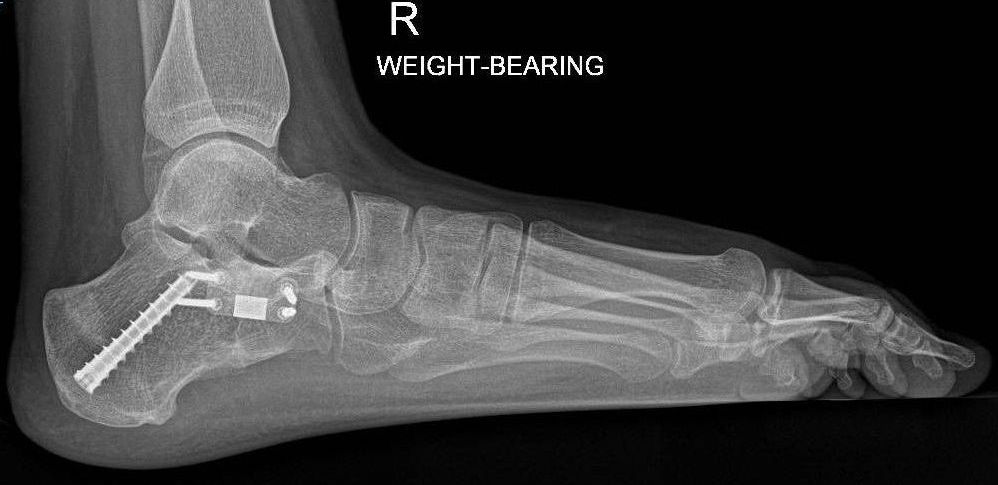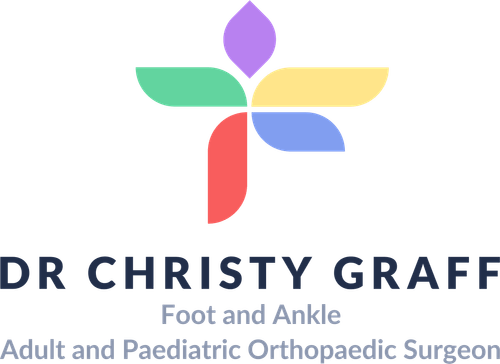Flat Foot Reconstruction
What is Flat Foot Reconstruction?
Flat foot reconstruction is a surgical procedure designed to correct a condition known as acquired flat foot (see Acquired Flat Foot Information sheet), where the arch of the foot collapses or does not develop properly. This condition can lead to pain, instability, difficulty walking, and even permanent deformities in severe cases. The surgery aims to restore the foot's natural arch, alleviate pain, improve functionality, and enhance overall quality of life. Flat foot reconstruction typically involves a combination of bone realignment, tendon repair or reinforcement, and/or ligament reconstruction.

Indications for Flat Foot Reconstruction
Flat foot reconstruction may be recommended for individuals experiencing the following:
- Chronic Pain and Discomfort: Persistent foot, ankle, or lower leg pain due to a collapsed arch.
- Difficulty Walking: Issues with mobility or an inability to engage in normal activities due to flatfoot.
- Progressive Deformity: Worsening of the flatfoot condition despite non-surgical treatments.
- Failed Non-Surgical Treatments: When methods such as orthotics, physical therapy, or medication have not provided relief.
- Severe Flatfoot: Advanced stages of flatfoot that lead to arthritis or significant structural abnormalities.
Benefits of Flat Foot Reconstruction
- Pain Relief: Reduced or eliminated pain in the foot and ankle.
- Improved Mobility: Enhanced ability to walk, run, and engage in physical activities.
- Restoration of Foot Function: Rebuilding the arch improves the biomechanical alignment of the foot.
- Prevention of Further Deformity: Addressing the condition surgically prevents the progression of flatfoot-related issues, such as arthritis.
- Enhanced Quality of Life: Greater comfort and independence in daily activities.
Types of Flat Foot Reconstruction
Flat foot reconstruction is not a single procedure but a collection of surgical techniques tailored to each patient’s condition. Common procedures include one or more of the following:
- Osteotomy: Realigning or reshaping the bones to restore the arch.
- Tendon Transfer or Repair: Using a healthy tendon (often from the same foot) to replace or support the damaged tibialis posterior tendon.
- Arthrodesis (Fusion): Fusing joints in the foot to improve alignment and stability.
- Soft Tissue Procedures: Tightening or reconstructing ligaments to improve the structural integrity of the foot.
- Combined Techniques: Many cases require combining the above procedures for optimal outcomes.
Alternative Options to Flat Foot Reconstruction
Before opting for surgery, patients can explore several non-surgical alternatives to manage flat foot symptoms:
- Orthotics: Custom-made shoe inserts to support the arch and improve alignment.
- Physical Therapy: Exercises to strengthen the foot and ankle muscles, improve flexibility, and reduce pain.
- Footwear Modifications: Wearing supportive shoes with good arch support and cushioning.
- Bracing: Ankle-foot orthoses (AFOs) can provide additional support for severe cases.
- Medication: Anti-inflammatory drugs or corticosteroid injections for pain relief.
- Lifestyle Modifications: Weight management and activity adjustments to reduce pressure on the foot.
Preparation Before a Flat Foot Reconstruction
Preparing for flat foot reconstruction is essential to ensure a smooth surgical experience and optimal recovery. Here are the steps you may need to take:
- Medical Evaluation: To plan the surgery effectively, undergo a comprehensive medical assessment, including physical exams and imaging tests like X-rays or MRIs.
- Discuss Medications: Inform Dr Graff about all medications, supplements, or herbal remedies you are taking. Some may need to be adjusted or paused before surgery to reduce risks.
- Preoperative Testing: Complete any required blood tests, ECGs, or other evaluations to confirm your suitability for anesthesia and surgery.
- Smoking Cessation: If you smoke, it's advisable to quit, as smoking can impede healing and increase complication risks.
- Arrange Transportation and Assistance: Plan for someone to drive you home after the surgery and assist you during the initial recovery period.
- Fasting Guidelines: Follow instructions regarding eating and drinking before surgery, typically fasting for at least 12 hours prior.
- Home Preparation: Organize your living space to accommodate limited mobility. This might include setting up a comfortable resting area and ensuring necessities are within easy reach.
Flat Foot Reconstruction Procedure
Flat foot reconstruction is customised to each patient's specific needs but generally involves several key steps:
- Anesthesia Administration: You'll receive general or regional anesthesia with sedation to ensure comfort during the procedure.
- Incision Making: Dr Graff makes strategic incisions to access the foot and ankle bones, tendons, and ligaments.
- Bone Realignment (Osteotomy): Bones may be cut and repositioned and held with screws and/or plates to restore the arch. This can involve removing bone wedges or adding grafts.
- Tendon Repair or Transfer: Damaged tendons are repaired, or healthy tendons are transferred to support the arch. The tibialis posterior tendon is often damaged, and its function needs to be restored or replaced.
- Ligament Reconstruction: Ligaments may be tightened or reconstructed to enhance joint stability.
- Joint Fusion (Arthrodesis): In severe cases, certain joints are fused to correct deformities and relieve pain.
Depending on the complexity, the surgery can take 2 to 5 hours.
What to Expect After a Flat Foot Reconstruction?
Following are the post-surgical guidelines to be followed after reconstruction:
- Make sure you get adequate rest. Avoid using the affected foot for a few weeks except when going to and from the toilet.
- Take medications to help alleviate pain and inflammation as your GP or Dr Graff prescribes.
- To reduce post-operative pain and swelling, apply ice bags over a towel to the affected area for 15-20 minutes.
- Keep the foot elevated at or above the level of your heart. This helps minimise swelling and discomfort.
- A wheelchair might be required for a few days in more severe cases.
- You may use crutches or a walker to maintain balance or stability while walking. You should also begin appropriate exercises to stretch and strengthen the muscles.
- Cover the boot while showering to keep it clean and dry.
The Hospital Stay
- You wake up with a half plaster (backslab) or a boot
- Your foot will be elevated overnight, and you will have antibiotics through a drip
- You will either blood thinning medication to help prevent DVT and vitamin C to help with wound healing
- You will stay in the hospital for 2-5 days with antibiotics, blood thinners, regular
- paracetamol, regular laxatives, regular vitamin C and stronger painkillers to take if and when required
- You will be only allowed to touch your foot to the ground for 6 weeks
- Depending on your balance and strength, you may need rehabilitation post-operatively
- Buying a second-hand knee scooter pre-operatively (you can search online) and practising at home before the surgery can be helpful; please bring it into the hospital with you. It is easier to use a knee scooter than crutches
When You Go Home
- You will need medications for pain relief; regular paracetamol (2 tablets four times a day) is recommended, as well as strong painkillers, especially at night before bed. These can have side effects of drowsiness, nausea and constipation, and other tablets to help with these side effects may be required.
- You will need to take blood thinners and vitamin C as prescribed
- You will need a shower chair and bags to keep the plaster dry
- You will need to attend your post-op appointment in 2-3 weeks, where the wounds will be checked and your plaster changed to a waterproof cast if your wounds are healed
- After this, you will be able to shower with a shower chair and get the plaster wet
Flat Foot Reconstruction Rehabilitation
All patients are different. These timelines are only guides, and some patients may progress faster or slower than others.
0 - 2 Weeks
- You will be in a backslab or moonboot for 2-3 weeks
- You can only touch your foot to the ground for balance.
- Please keep your foot elevated and out of bed for toilet only
- You will need to bag the leg for showers
- Pain relief: Please take regular paracetamol with meals and before bed; stronger painkillers are often needed, especially before bed
- Please take blood thinners and vitamin C as prescribed
2 - 3 Weeks
- Post-op appointment with Dr Graff: dressings are changed, and an x-ray is taken
- You will then go into a full cast (often waterproof if the wounds are okay) or stay in the moonboot full-time for another 3-4 weeks
- You will still need to elevate the foot at rest
- You can start static strengthening leg lifts with physiotherapy
6 Weeks
- You will have an appointment with Dr Graff and an x-ray
- If you have a cast, it will be removed, and you can start weight-bearing in a boot for 6 weeks
- You can continue isometric tibialis posterior strengthening and active range of movement with physiotherapy
12 Weeks
- You will have another appointment with Dr Graff and an x-ray;
- You can start weight bearing without the boot if you can fit into normal shoes (rocker bottom shoes with medial arch support)
- You can start swimming and cycling
- You can commence eccentric tibialis posterior strengthening with physio
When can I drive?
- Left foot 6 weeks (if driving an automatic car)
- Right foot 12 weeks
When can I return to work?
- Seated work at 2-3 months
- Prolonged standing 6-9 months
- Heavy labour work 12-18 months
Adherence to the recovery plan and attendance at all follow-up appointments are crucial for success.
Flat Foot Reconstruction Prognosis
The long-term outlook after flat foot reconstruction is generally favourable. Most patients experience a significant reduction or elimination of foot and ankle pain. They also experience an enhanced ability to walk and perform daily activities without discomfort and a restoration of the foot's natural arch and alignment.
Individual results can vary based on the severity of the condition and adherence to postoperative care.
Flat Foot Reconstruction Risks
Potential risks and complications include:
- Infection
- Bleeding or Hematoma
- Nerve Injury
- Delayed Bone Healing
- Scar Formation
- Blood Clots
- Residual Deformity or Recurrence
- Anesthesia Complications
Implications of Delaying Flat Foot Reconstruction
Delaying surgery may lead to the following:
- Worsening Symptoms: Increased pain and decreased mobility.
- Progressive Deformity: Further collapse of the arch and foot misalignment.
- Joint Degeneration: Higher likelihood of developing arthritis in the foot and ankle joints.
- Limited Treatment Options: Advanced deformities might require more complex surgeries with longer recovery times.
- Impact on Quality of Life: Ongoing discomfort can affect daily activities and well-being.
Early intervention is often recommended to prevent these potential complications.
Useful Websites
For reliable information and resources on flat foot reconstruction, consider visiting:
- Australian Orthopaedic Foot & Ankle Society: Provides patient education materials and a directory of specialist surgeons.
- Better Health Channel (Victoria State Government): Offers comprehensive health information, including foot conditions and treatments.
- Healthdirect Australia: A national, government-funded service providing quality-checked health information.
Contact Us
If you want more information or have any questions or problems, please contact Dr Graff at admin@christygraff.com or call the rooms at 0493 461 133.
